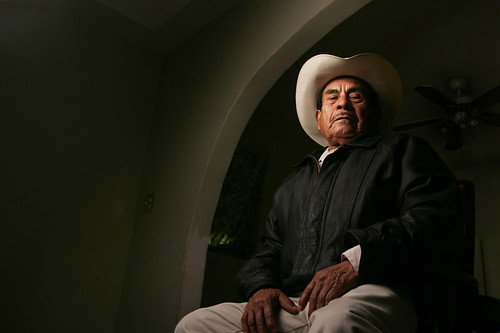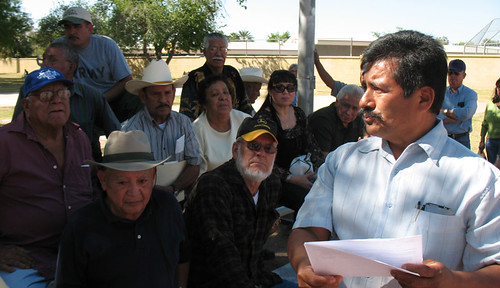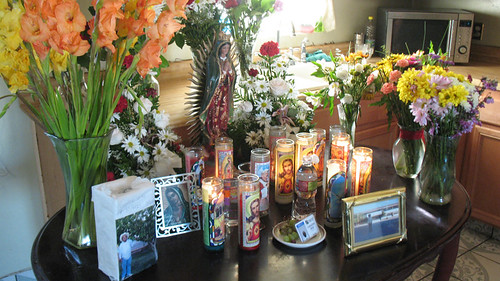PHOENIX, Arizona — Flowers in hand, day or night, visitors have been coming to the little house of Catalino Díaz Villa‘s widow to pay their respects after his death. Some never met him, but to them he is a brother. They share a common bond: they all were farmworkers in the American countryside as part of the Bracero Program over 50 years ago.
Díaz Villa, 84, died in a traffic accident when a vehicle struck him while crossing the street. It was the Fourth of July, but he was working as usual. He made a living by selling cans and metal scraps he picked up on the streets of central Phoenix.
He was part of a generation of aging braceros struggling to survive without a pension, hoping to win a fight to recover wages withheld from them decades ago as part of a controversial guest-worker program between Mexico and the U.S. The money that was supposed to be given to the workers to encourage them to return to their country was instead kept by Mexico.
Diaz Villa was born in Icatepec, a small town in the Mexican state of Guerrero. He became a bracero at age 30 and worked in California from 1955 to 1957 for $5 a day. Later, he returned to work across the border until he grew tired of being caught by the border patrol, said his wife, Constantina Rodríguez Moreno Díaz, 74.
Listen to Constantina (in Spanish):
[audio:http://www.jocelyngonzales.net/FI2W/valeria_constantina.mp3]
“He told me: I’m leaving for the U.S as a bracero. He was always saying he wanted to come as a bracero. And so he came to work, he started sending money, it was a little but he started to send it, right then. He came on ’55 and left on ’57.
“…San Joaquín, California. That’s where he said he was looking for work that a rancher found them. He’d take them to Manteca, and they where around that area. He told me he cut berries, onions, cherries and beets. It was a tough job, that’s what he said. But he was given few hours too. His bracero papers were very important to him.”
In 1991, Catalino and his wife decided to return to the U.S. because it was getting harder to make a living in Mexico and they had a chance to stay with family in Phoenix.
But life here wasn’t easy either. In 2000, Díaz Villa was let go from his job in a landscaping company because he was “too old to work,” said his wife. He didn’t have documents. Without a pension or retirement benefits, he started working on the streets picking up metal and cans to make ends meet.
For years, Díaz Villa spent weekends socializing with aging braceros in city parks, reminiscing about their past like war veterans. Their meetings weren’t only to share memories but also to organize to recover some of the money taken from them. Last May, they picketed outside the Mexican Consulate.
Gregorio León, 51, an organizer of one of the local bracero groups, knew Díaz Villa well. He said he was very active in the bracero grassroots movement. He calls him compañero in Spanish, which translates as comrade but is also another way of saying “friend.”
“It’s too sad the Mexican government hasn’t given them what is theirs,” he said. “And that many of them are getting old and dying without seeing a change. What happened to Catalino was unfortunate.”
Listen to Gregorio (in Spanish):
[audio:http://www.jocelyngonzales.net/FI2W/valeria_gregorio.mp3]
“They’re fighting for something that the government kept and right there they show a spirit and attitude to defend their dignity as people, as human beings.
“Defending what belongs to them makes them stand out. I hope future generations learn that the dignity of a human being is not negotiable. And that is my admiration for our comrades and our comrade Catalino.”
The Mexican government has been paying a one-time lump sum of about $3,000 to braceros who can prove their claim. Since 2005, some 42,000 have received the payment. Yet it was not until last year that those who reside in the U.S. were allowed to demand the money, after a class-action lawsuit against the Mexican state in a California court ended in a victory for the former workers.
On December, Díaz Villa took his bracero card or “mica” to the Mexican Consulate to file a claim for the money. But he didn’t hear back.
“He was very active in our fight,” said Nieves Acosta, 69, a fellow ex-bracero who attended his funeral on Friday, July 17. “To me, he is a brother.”
Listen to Nieves (in Spanish):
[audio:http://www.jocelyngonzales.net/FI2W/valeria_nieves.mp3]
“I feel like all of us who were braceros were brothers. A ton of us would come, it was thousands of braceros coming to work to the U.S., in fields with five thousand, seven thousand men. We lived in long barracks in very big fields.
“I would have liked it if Catalino could receive the money that they took from him. I wish he would have been able to enjoy at least a bit of that, that he would have bought something for himself.”
Margarito Blancas, one of Díaz Villas’ nephews, is happy to know that memories of his uncle are still alive. The Bracero History Archive, a project that documents braceros‘ oral history, recorded an hour-long interview in Spanish with him about his experiences as a guest worker.
Díaz Villa knew how to make friends on every street corner, said his wife. He even found friends in people he didn’t know at all.
Elizabeth Herrera Martinez, 36, a flower shop owner arrived at his funeral with a bouquet full of red roses. She had never met him. But his death brought her memories of her father, who passed away five years ago. He too was a bracero.
When her father found out money had been taken from his paycheck he started asking about it. She regrets he didn’t get an answer. Díaz Villa didn’t either.
“It’s not really the money,” she said. “It’s the recognition of their work and effort.”





